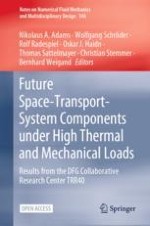1 Introduction
2 High Aspect Ratio Cooling Duct
2.1 Equation System and Numerical Model
2.2 Simulation Setup
2.3 Flow and Temperature Field
 ) and the BSL RSM with \(Pr_t = 0.85\) (
) and the BSL RSM with \(Pr_t = 0.85\) (
 ), \(Pr_t = 0.9\) (
), \(Pr_t = 0.9\) (
 ), Daly-Harlow model (
), Daly-Harlow model (
 ), Younis model (
), Younis model (
 ) and PDE model (
) and PDE model (
 ). In a/b the adiabatic results are plotted as dotted lines. In a/c the analytical law of the wall and the empirical function of Kader are plotted as (
). In a/b the adiabatic results are plotted as dotted lines. In a/c the analytical law of the wall and the empirical function of Kader are plotted as (
 )
)3 Channel Flow with Strong Property Variations
3.1 Equation System and Numerical Model
3.2 Simulation Setup
3.3 Flow and Temperature Field
 ). LES (
). LES (
 ), BSL RSM with \(Pr_t = 0.85\) (
), BSL RSM with \(Pr_t = 0.85\) (
 ) and BSL RSM with Kays and Crawford model (
) and BSL RSM with Kays and Crawford model (
 )
) ), BSL RSM with \(Pr_t = 0.85\) (
), BSL RSM with \(Pr_t = 0.85\) (
 ) and BSL RSM with Kays and Crawford model (
) and BSL RSM with Kays and Crawford model (
 )
)\(\tau _{w_c} \left[ \text {Pa}\right] \) | \(\tau _{w_h} \left[ \text {Pa}\right] \) | \( |\dot{q}_{w_c}| \left[ \text {MW m}^{-2}\right] \) | \( |\dot{q}_{w_h}| \left[ \text {MW m}^{-2}\right] \) | |
|---|---|---|---|---|
LES | 1257 | 708 | 3.48 | 3.00 |
BSL RSM with \(Pr_t = 0.85\) | 2420 | 802 | 5.26 | 4.95 |
BSL RSM with KC | 2410 | 804 | 5.03 | 4.72 |
